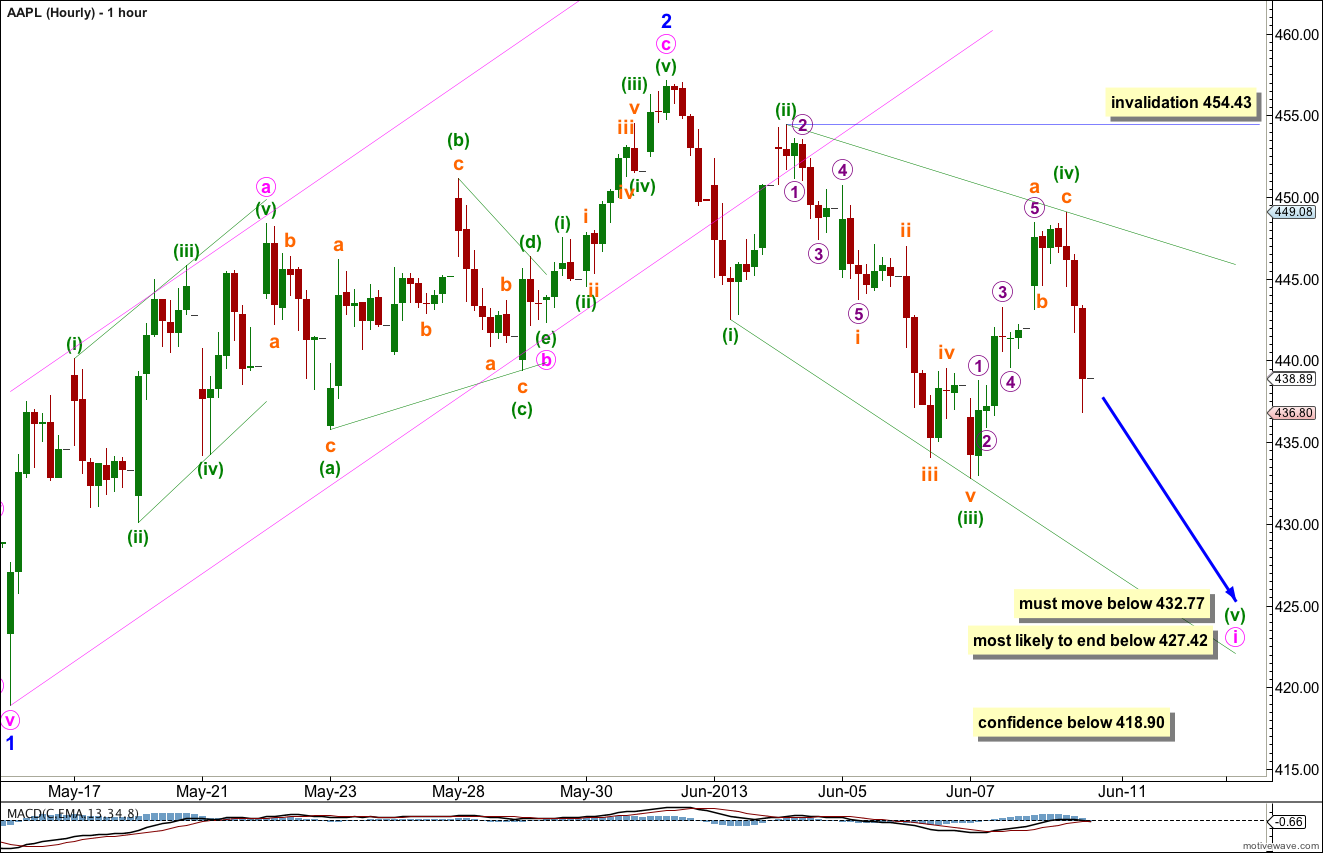Last analysis expected downwards movement to a short term target at 430.77 to 428.48. Price reached down to 432.77, $2 short of the target zone, before turning upwards.
Overall the trend looks like it remains downwards for AAPL.
Click on the charts below to enlarge.
This wave count expects a five wave impulse for a cycle degree wave a is unfolding to the downside. Within the impulse primary waves 1 and 2 are complete. Primary wave 3 is extending. Within primary wave 3 intermediate waves (1) and (2) are complete.
Within intermediate wave (2) running flat minor wave C is just 2.17 short of 1.618 the length of minor wave A.
At 381 minor wave 3 would reach 1.618 the length of minor wave 1.
At 289.78 intermediate wave (3) would reach equality in length with intermediate wave (1). When there is more structure within intermediate wave (3) to analyse I will add a target calculation at minor degree for it to end, so this target will probably change.
At 272 primary wave 3 would reach 1.618 the length of primary wave 1. This long term target is still months away.
Within intermediate wave (3) no second wave correction may move beyond the start of its first wave. This wave count is invalidated with movement above 465.75.
I have considered various possibilities for this downwards movement from the high labeled primary wave 2. What is most clear is that the middle of primary wave 3 has not yet passed because we have not seen momentum increase beyond that seen for primary wave 1. Primary wave 3 cannot be complete.
When this next five wave impulse labeled primary wave 3 is complete we shall have to consider that may be the end of cycle wave a as a three wave zigzag if super cycle wave II is unfolding as a big flat correction. I will consider that alternative at the appropriate time if it remains viable.
Within minor wave 3 minute wave i may be unfolding as a leading diagonal. This would explain the overlapping movement, trending downwards.
Within minute wave i leading diagonal minuette waves (ii) and (iv) must subdivide into zigzags. Minuette wave (ii) is 81% of minuette wave (i) and minuette wave (iv) is 74% of minuette wave (iii). Both these corrections are within the most common length of 0.66 to 0.81. This looks like it may be a typical expanding diagonal, so far.
The diagonal would be expanding because minuette wave (iv) is longer than minuette wave (ii), and minuette wave (iii) is longer than minuette wave (i). We should expect minuette wave (v) to most likely be longer than minuette wave (iii) and so to end below 427.42.
For a leading diagonal the fifth wave may not be truncated. Mineutte wave (v) must make a new low below the end of mineutte wave (iii) at 432.77.
Following a leading diagonal in a first wave position we would expect a very deep second wave correction. When minuette wave (v) completes the diagonal we should expect minute wave ii to reach to 0.618 the length of minute wave i or above.
Within the diagonal on the five minute chart minuette wave (iv) looks very much like a zigzag and it has a corrective wave count. It is most likely over there. However, if it is not over and if it continues higher it may not move beyond the end of minuette wave (ii). This wave count is invalidated with movement above 454.43.


